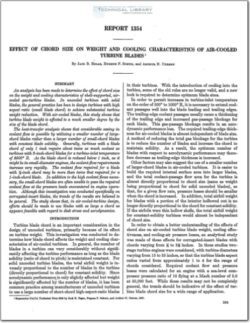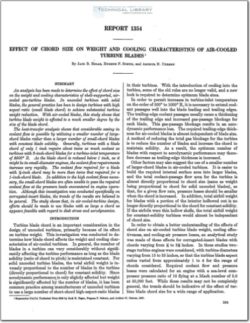NACA-Report-1354

- Version
- 222 Downloads
- 1.54 MB File Size
- 1 File Count
- December 4, 2015 Create Date
- December 4, 2015 Last Updated
National Advisory Committee for Aeronautics, Report - Effect of Chord Size on Weight and Cooling Characteristics of Air-Cooled Turbine Blades

An analysis has been made to determine the eject of chord size
on the weight and cooling characteristics of shell—supported, air-
cooled gas-turbine blades. In uncooled turbines with solid
blades, the general practice has been to design turbines with high
aspect ratio (small blade chord) to achieve substantial turbine
weight reduction. With air~cooled blades, this study shows that
turbine blade weight is afiected to a much smaller degree by the
size of the blade chord.
The heat-transfer analysis shows that considerable saving in
coolant flow is possible by utilizing a smaller number of large-
chord blades rather than a larger number of small-chord blades
with constant blade solidity. Generally, turbines with a blade
chord of only 1 inch require about twice as much coolant as
turbines with 3-inch-chord blades for a turbine-inlet temperature
of 2500° R. As the blade chord is reduced below 1 inch, as it
might be in small-diameter engines, the coolant-flow requirements
increase very rapidly. The coolant flow required for a blade
with 34-inch chord may be more than twice that required for a
I-inchr-chord blade. In addition to the high coolant flows neces—
sary, the small—chord blades are often unable to pass the required
coolant flow at the pressure levels encountered in engine opera—
tion. Although this investigation was conducted specifically on
corrugated-insert blades, the trends of the results are believed to
be general. The study shows that, in air-cooled-turbine design,
efiorts should be made to use blades with as large a chord as
appears feasible with regard to disk stress and aerodynamics.
Turbine blade chord is an important consideration in the
design of uncooled turbines, primarily because of its effect
on turbine weight. This investigation was conducted to de—
termine how blade chord affects the weight and cooling char—
acteristics of air-cooled turbines. In general, the number of
blades in a turbine can vary considerably without signifi-
cantly affecting the turbine performance as long as the blade
solidity (ratio of chord to pitch) is maintained constant. For
solid uncooled turbine blades, the total airfoil weight is in—
versely proportional to the number of blades in the turbine
(directly proportional to chord) for constant solidity. Since
aerodynamic performance is only slightly affected but weight
is significantly affected by the number of blades, it has been
common practice among manufacturers of uncooled turbines
to use a large number of short-chord high-aspect-ratio blades
in their turbines.
| File | Action |
|---|---|
| naca-report-1354.pdf | Download |

Comment On This Post